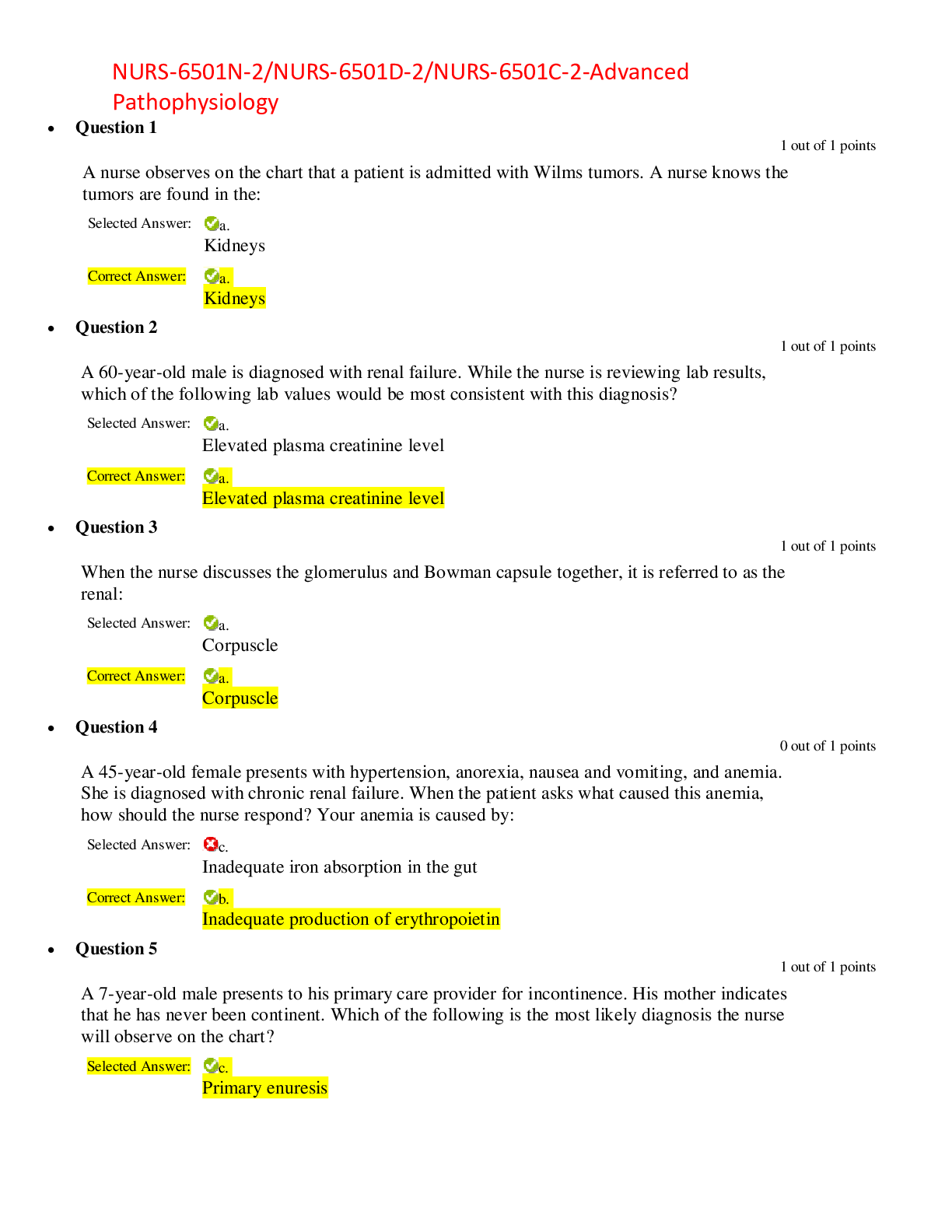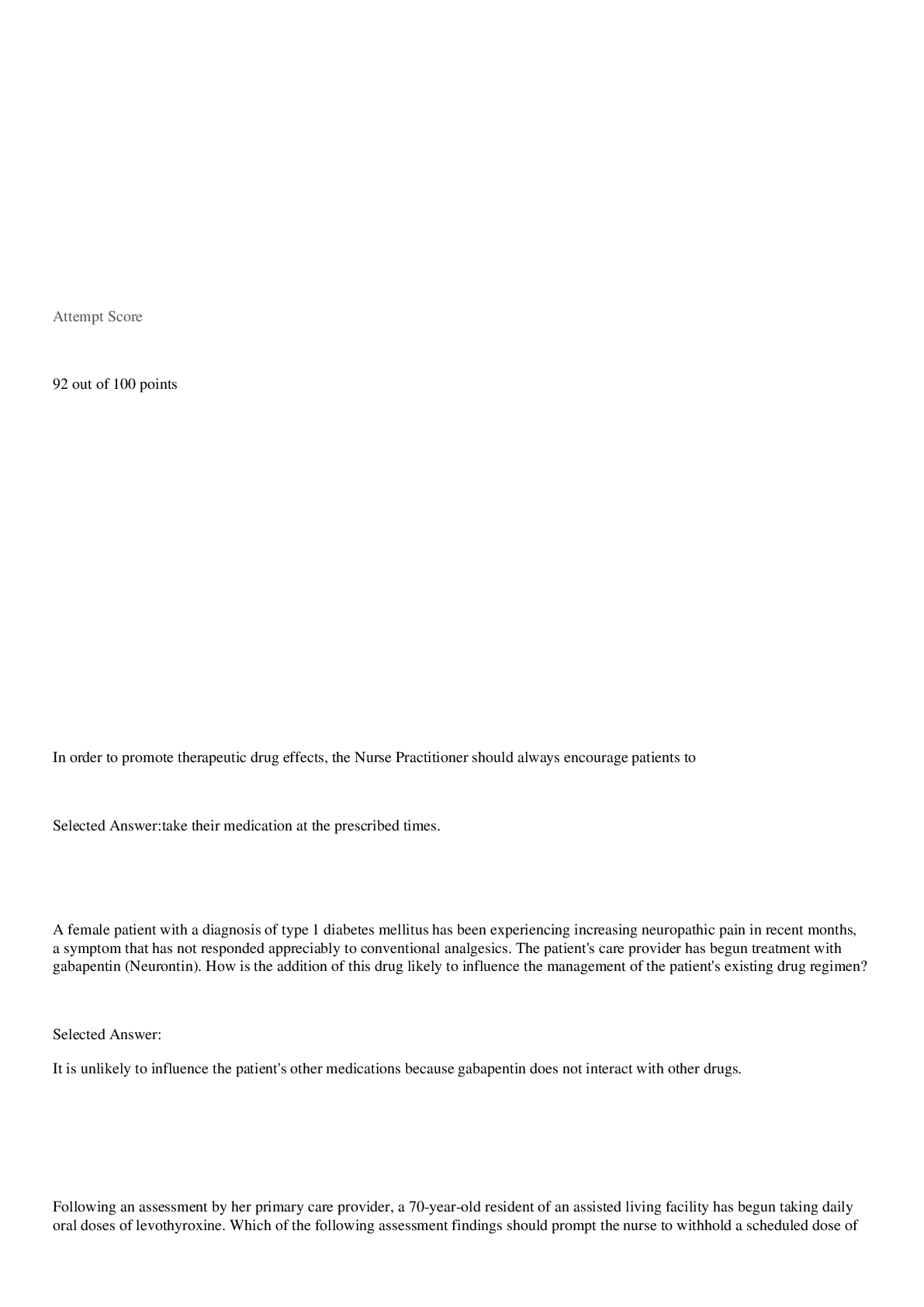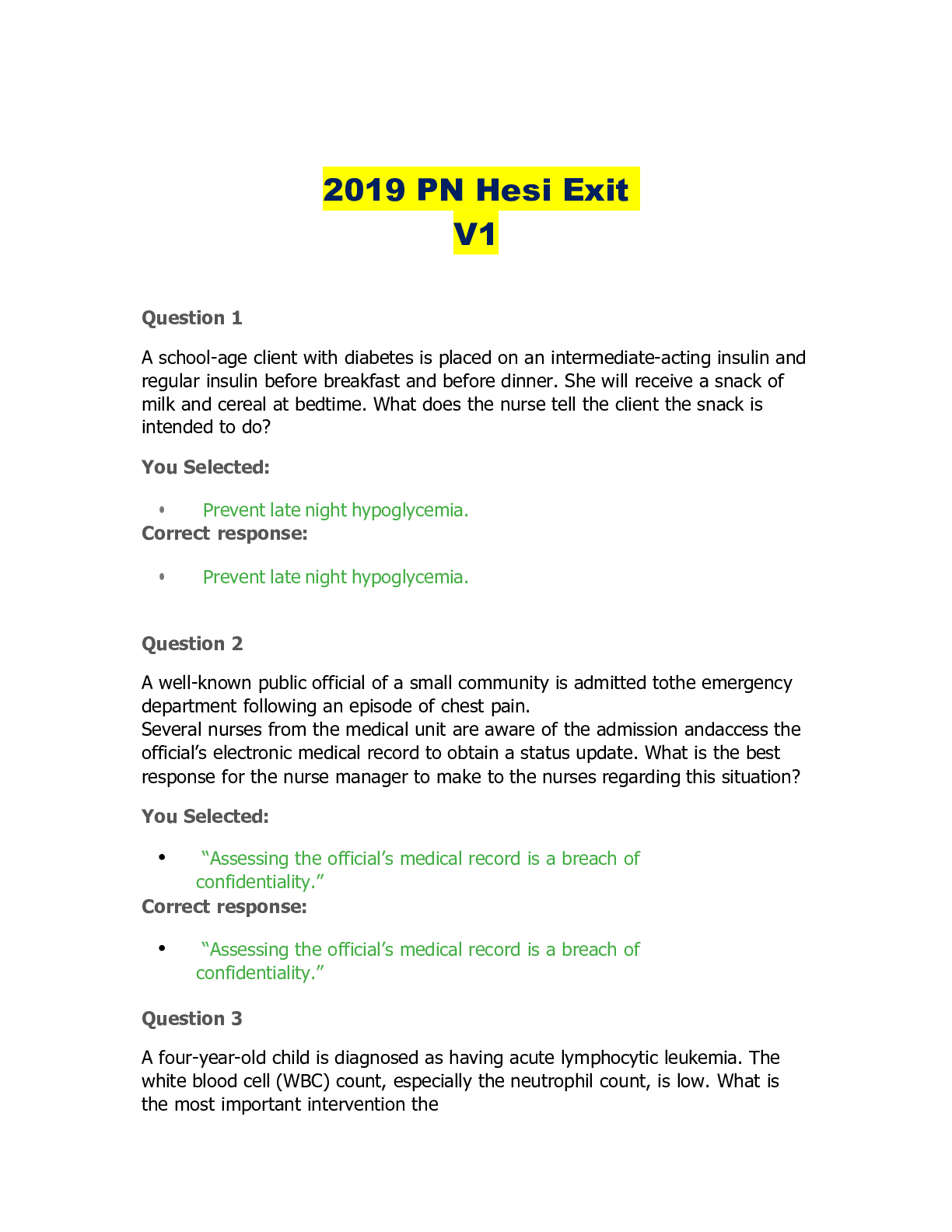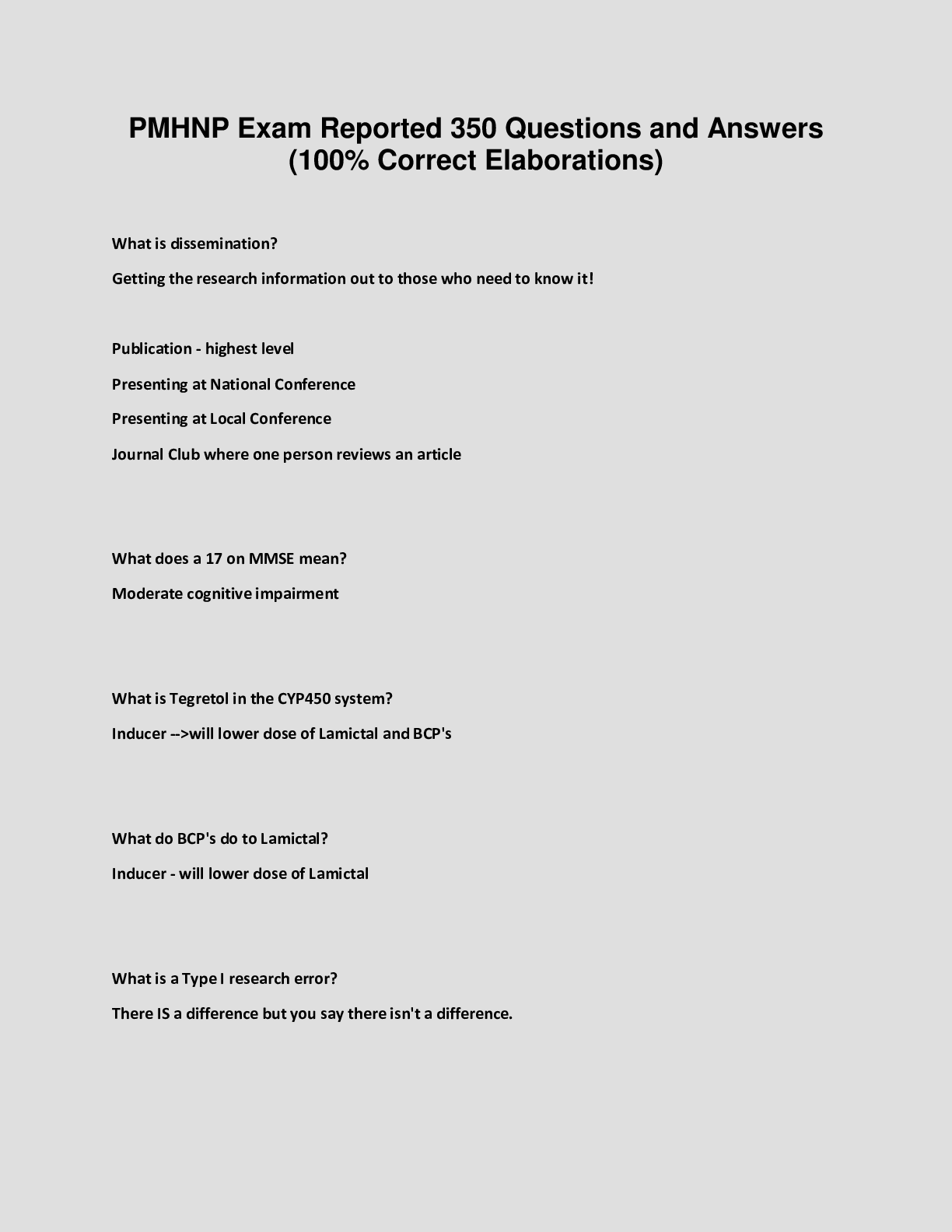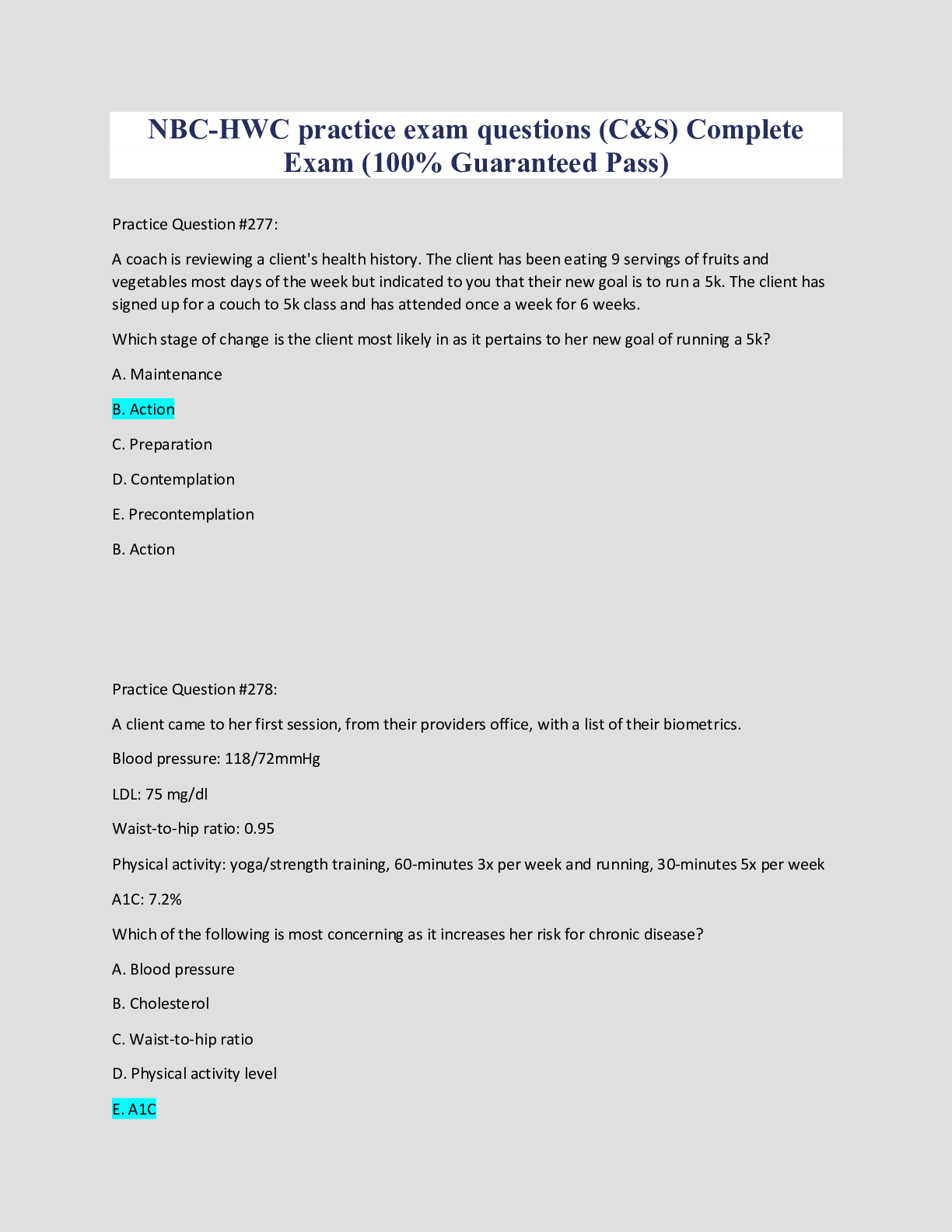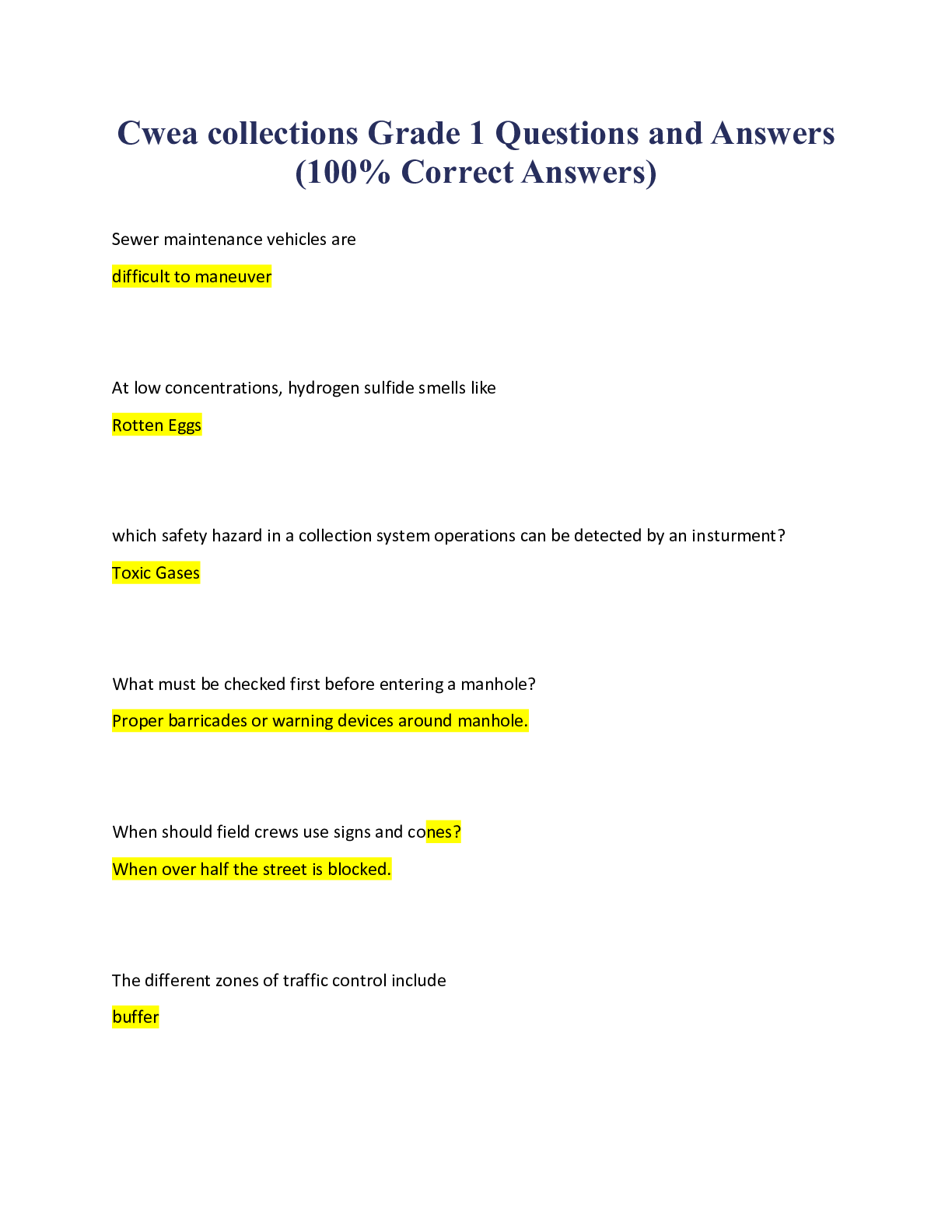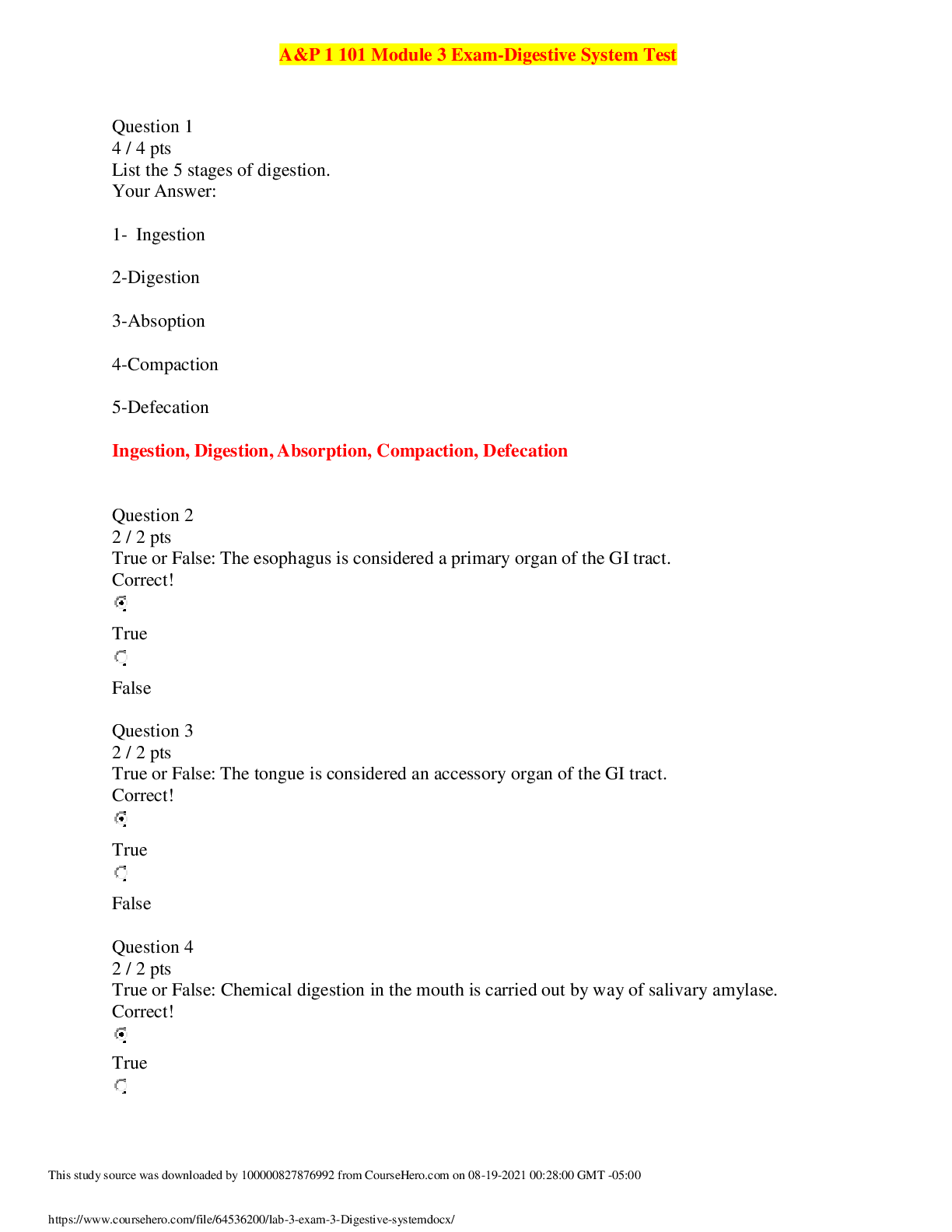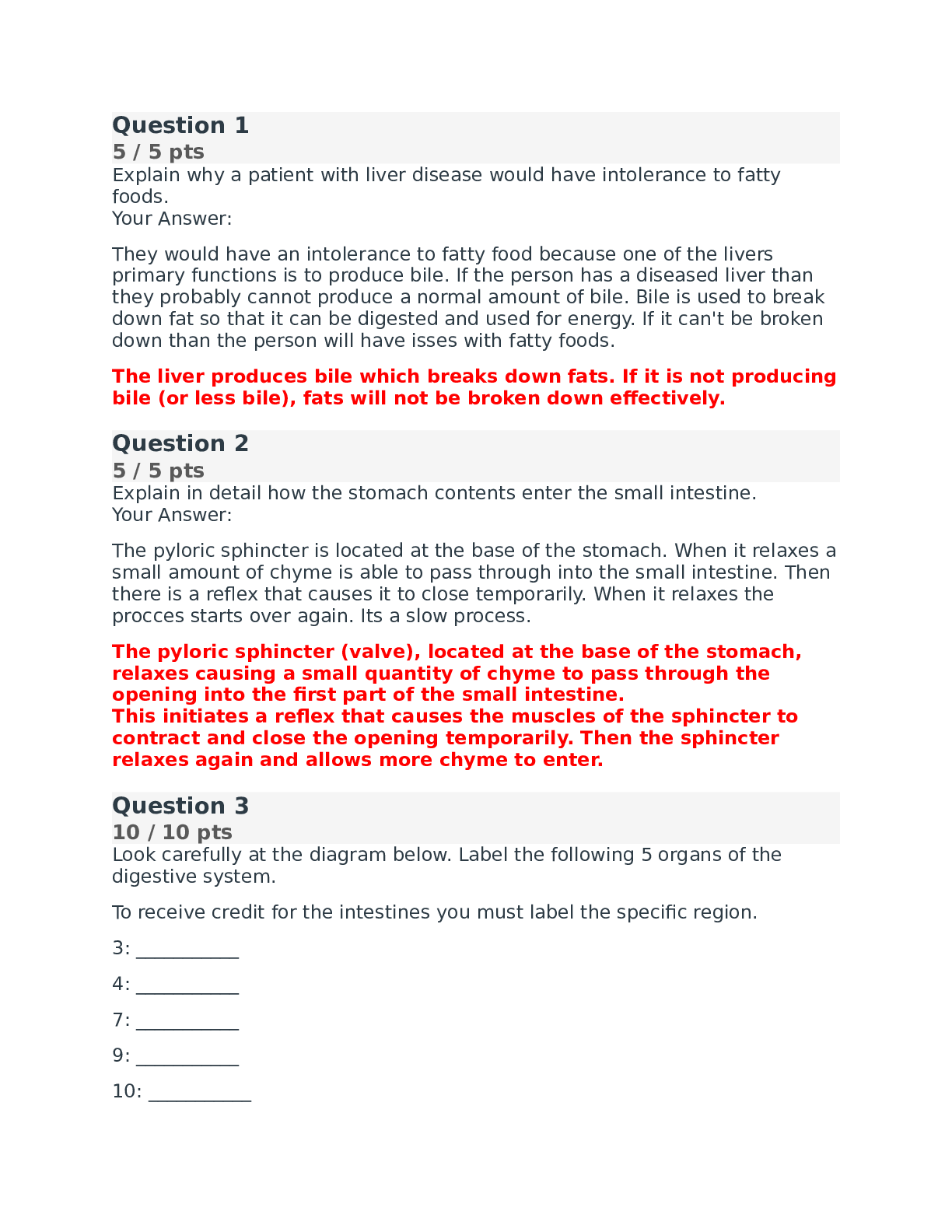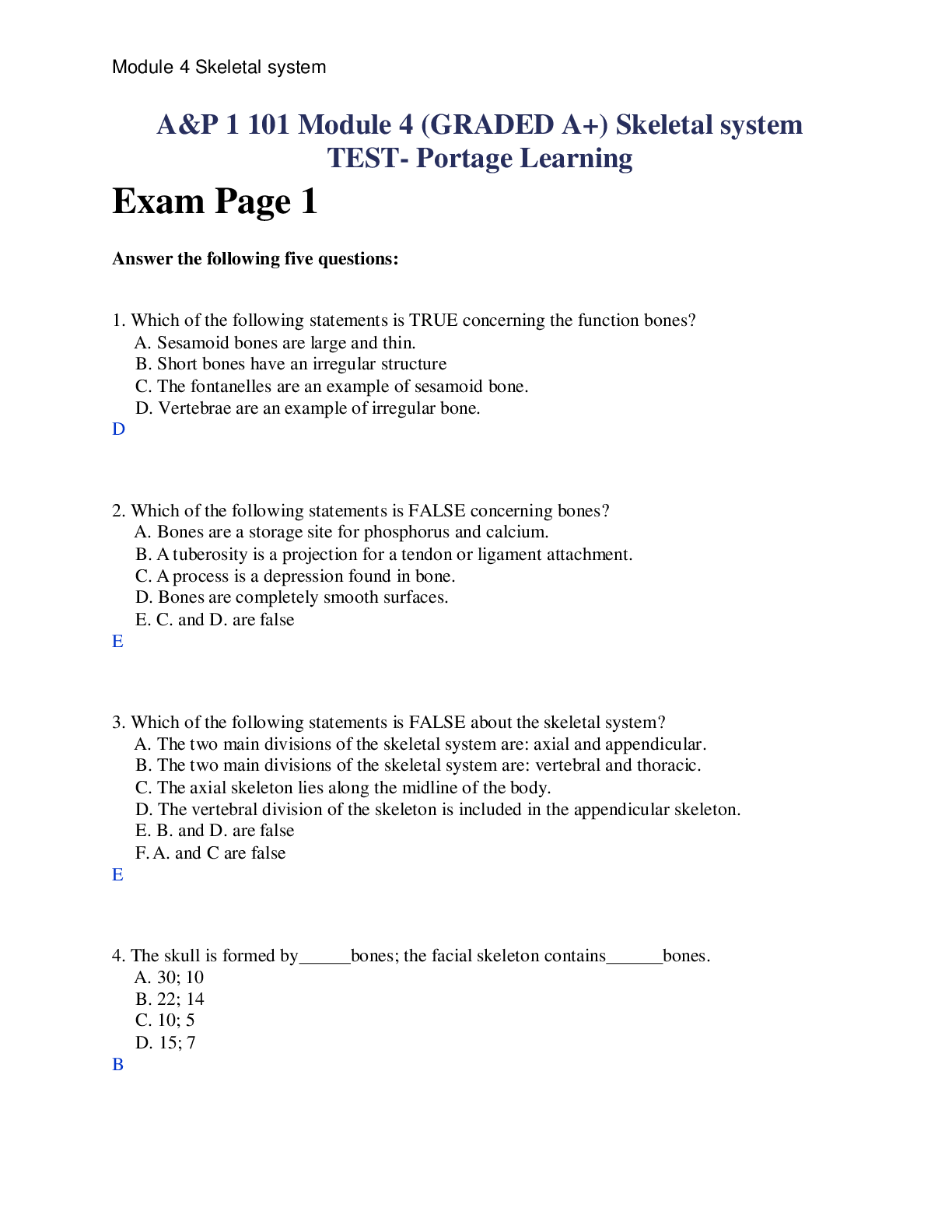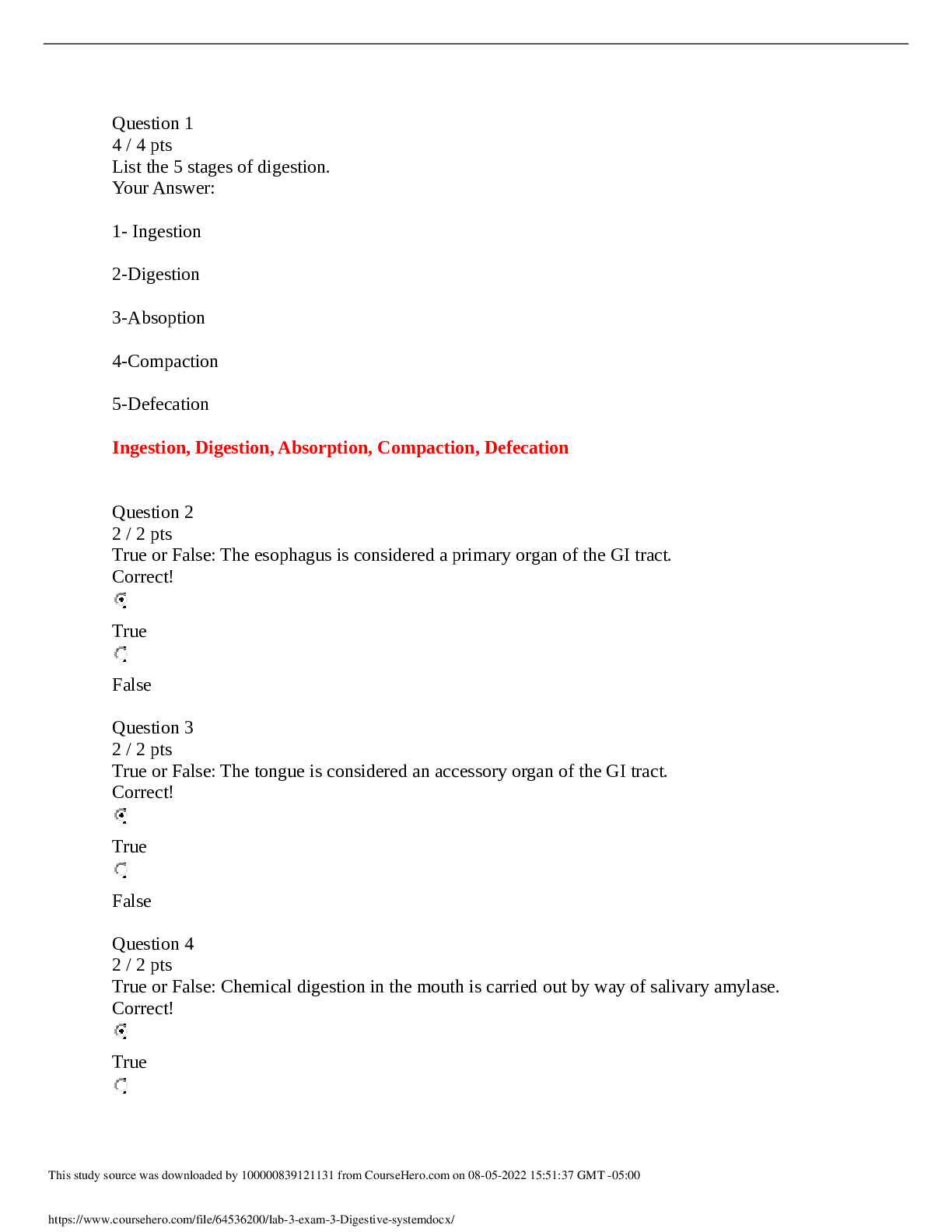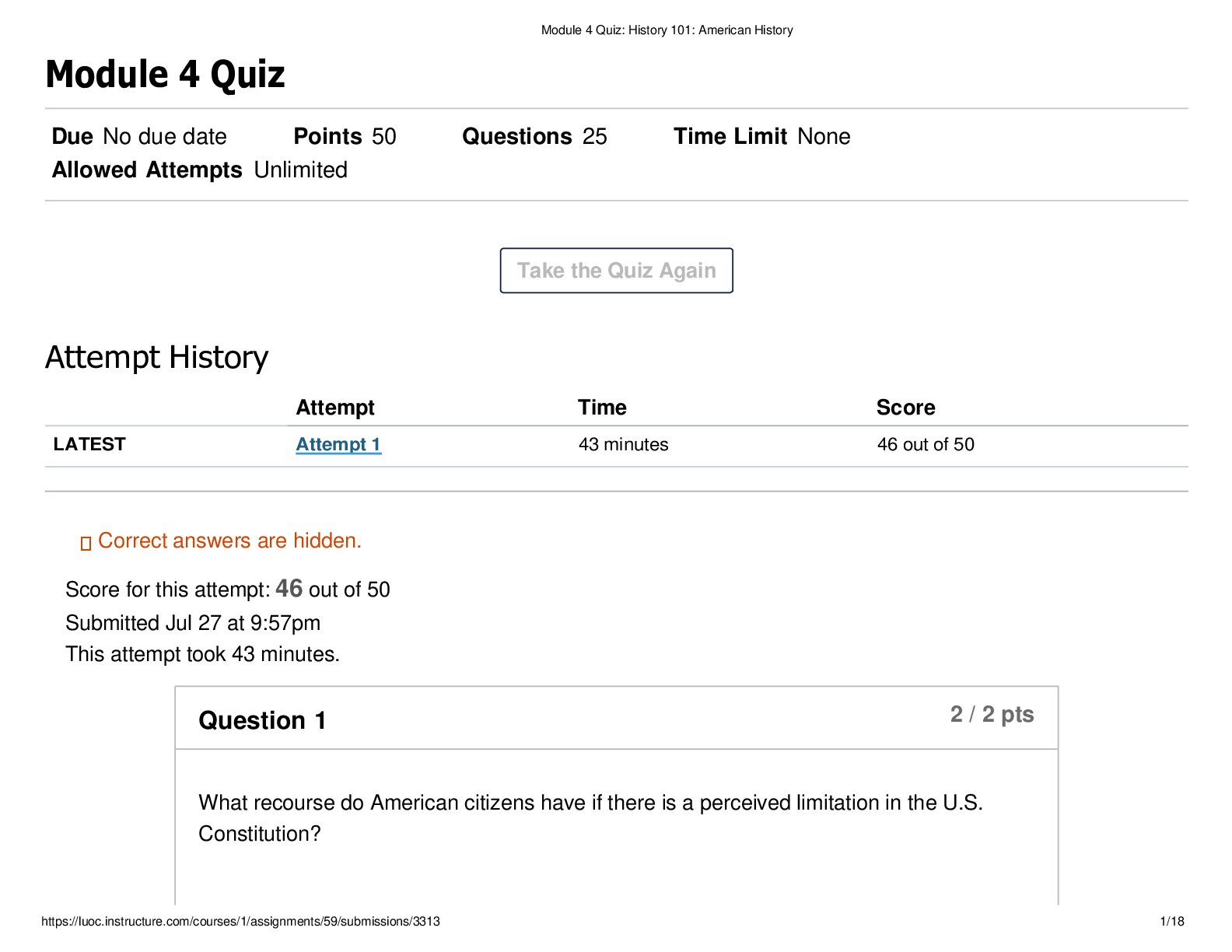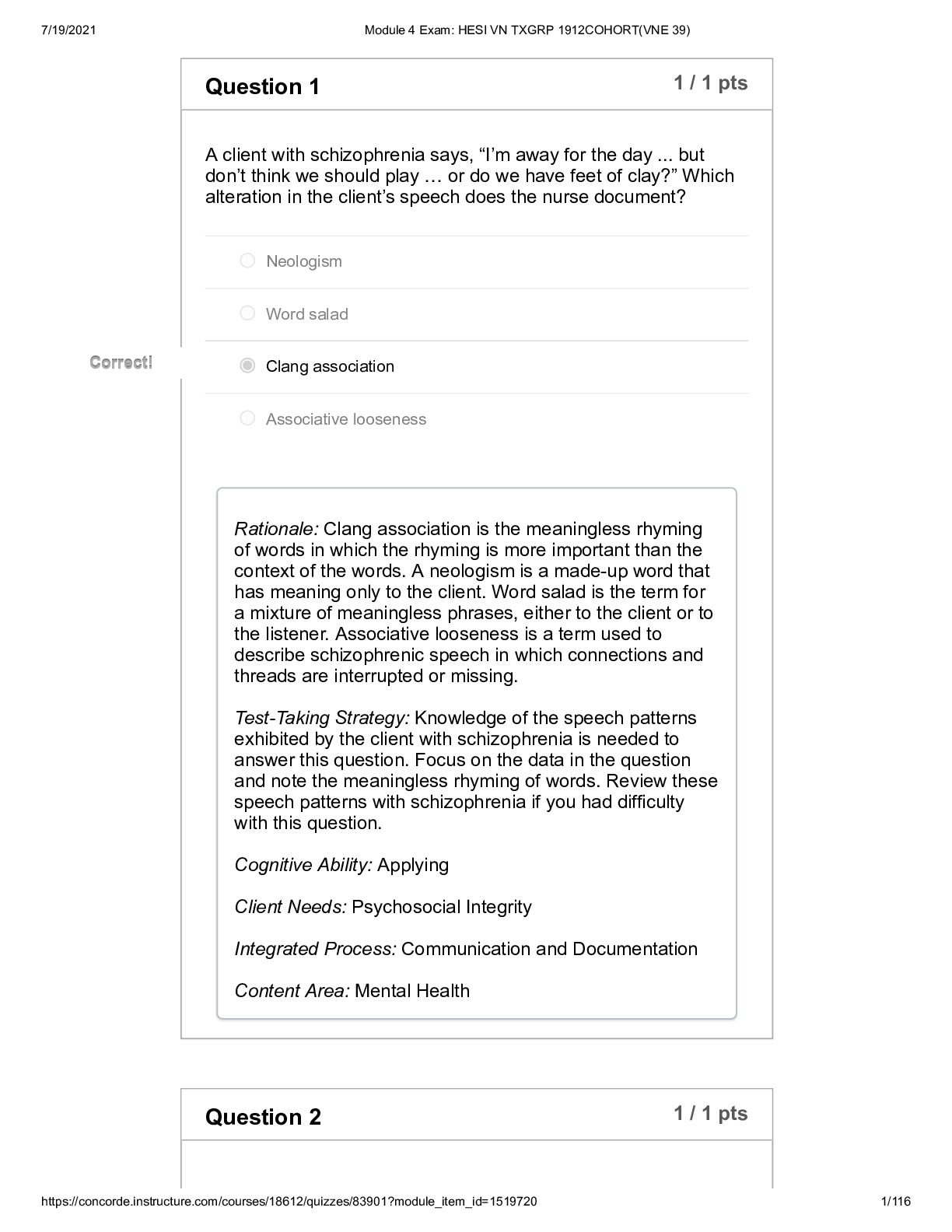A&P 1 101 Module 4 (GRADED A+) Skeletal system TEST- Portage Learning
Document Content and Description Below
A&P 1 101 Module 4 Exam Page 1 Answer the following five questions: 1. Which of the following statements is TRUE concerning the function bones? A. Sesamoid bones are large and thin. B. Shor... t bones have an irregular structure C. The fontanelles are an example of sesamoid bone. D. Vertebrae are an example of irregular bone. D 2. Which of the following statements is FALSE concerning bones? A. Bones are a storage site for phosphorus and calcium. B. A tuberosity is a projection for a tendon or ligament attachment. C. A process is a depression found in bone. D. Bones are completely smooth surfaces. E. C. and D. are false E 3. Which of the following statements is FALSE about the skeletal system? A. The two main divisions of the skeletal system are: axial and appendicular. B. The two main divisions of the skeletal system are: vertebral and thoracic. C. The axial skeleton lies along the midline of the body. D. The vertebral division of the skeleton is included in the appendicular skeleton. E. B. and D. are false F. A. and C are false E 4. The skull is formed by bones; the facial skeleton contains bones. A. 30; 10 B. 22; 14 C. 10; 5 D. 15; 7 B 5. What bone is highlighted in blue in the figure below? (superior/internal view) Sphenoid bone Answer Key 1. Which of the following statements is TRUE concerning the function bones? A. Sesamoid bones are large and thin. B. Short bones have an irregular structure C. The fontanelles are an example of sesamoid bone. D. Vertebrae are an example of irregular bone. 2. Which of the following statements is FALSE concerning bones? A. Bones are a storage site for phosphorus and calcium. B. A tuberosity is a projection for a tendon or ligament attachment. C. A process is a depression found in bone. D. Bones are completely smooth surfaces. E. C. and D. are false 3. Which of the following statements is FALSE about the skeletal system? A. The two main divisions of the skeletal system are: axial and appendicular. B. The two main divisions of the skeletal system are: vertebral and thoracic. C. The axial skeleton lies along the midline of the body. D. The vertebral division of the skeleton is included in the appendicular skeleton. E. B. and D. are false F. A. and C are false 4. The skull is formed by bones; the facial skeleton contains bones. A. 30; 10 B. 22; 14 C. 10; 5 D. 15; 7 5. What bone is highlighted in blue in the figure below? (superior/internal view) Copyright © 2020 Portage Learning. All Rights Reserved. Exam Page 2 1. Label the following bones of the skeleton from the figure below: 2:Nasal bone 4:zygomatic bone 6:inferior nasal concha 7:maxilla 8: mandible Answer Key 1. Label the following bones of the skeleton from the figure below: 4: 6: 7: 8: Copyright © 2020 Portage Learning. All Rights Reserved. Exam Page 3 Answer the following three questions: 1. Label the following vertebrae as: A= Cervical B= Thoracic C= Lumbar c 2. Label the following vertebrae as: A= Cervical B= Thoracic C= Lumbar b 3. What is the name of the foramina in the figure below? 1:Carotid canal 2:external acoustic meatus 3:stylomastoid foramen -3.0 points Answer Key 1. Label the following vertebrae as: A= Cervical B= Thoracic C= Lumbar 2. Label the following vertebrae as: A= Cervical B= Thoracic C= Lumbar 3. What is the name of the foramina in the figure below? 1: Foramen ovale 2: 3: Copyright © 2020 Portage Learning. All Rights Reserved. Exam Page 4 1. Label the following bone landmarks: A:head C:lesser tubercle F:deltoid tuberosity I:capitulum K:medial epicondyle Answer Key 1. Label the following bone landmarks: C: F: I: K: Copyright © 2020 Portage Learning. All Rights Reserved. Exam Page 5 Answer the following three questions: 1. Which of the following statements is TRUE about the scapula? A. The clavicle connects to the scapula anteriorly near the midline of the human body. B. The medial border of the scapula connects directly to the neck of the scapula. C. The subscapular fossa is located on the anterior side of the scapula. D. The scapula articulates with the clavicle at the neck of the scapula. c 2. Which of the following statements is FALSE about the humerus? A. The trochlea articulates with the ulna. B. The head of the humerus articulates with the ulna. C. The capitulum articulates with the radius. D. The medial epicondyle is the prominent bone landmark of the medial side of the elbow (in anatomical position). E. A. and B. are false e 3. What two bones meet at the glenohumeral joint? In your own words, why is this joint prone to dislocation? The humerus and scapula. The joint is prone to dislocation because it is held in place primarly by muscular and ligament attachment with very little stability. Answer Key 1. Which of the following statements is TRUE about the scapula? A. The clavicle connects to the scapula anteriorly near the midline of the human body. B. The medial border of the scapula connects directly to the neck of the scapula. C. The subscapular fossa is located on the anterior side of the scapula. D. The scapula articulates with the clavicle at the neck of the scapula. 2. Which of the following statements is FALSE about the humerus? A. The trochlea articulates with the ulna. B. The head of the humerus articulates with the ulna. C. The capitulum articulates with the radius. D. The medial epicondyle is the prominent bone landmark of the medial side of the elbow (in anatomical position). E. A. and B. are false 3. What two bones meet at the glenohumeral joint? In your own words, why is this joint prone to dislocation? Humerus and scapula Copyright © 2020 Portage Learning. All Rights Reserved. Exam Page 6 1. Label the bones in the figure below: A:pisiform B:hamate C:capitate D:trapezoid E: trapezium 2. Label the bones in the figure below: A:cuboid C:intermediate cuneiform D:medial cuneiform F:navicular G:calcaneus Answer Key 1. Label the bones in the figure below: B: C: D: E: 2. Label the bones in the figure below: C: D: F: G: Copyright © 2020 Portage Learning. All Rights Reserved. Exam Page 7 Answer the following five questions: 1. Yellow bone marrow: A. is found primarily in long bones. B. is found primarily in short and flat bones. C. is found primarily in newborns, not adults. D. produces red blood cells. a 2. The diaphysis of a bone: A. is found at the ends of long bones. B. contains the articular cartilage at joint articulations. C. contains the proximal epiphysis. D. is the center length of a bone. E. both A. and C. c 3. Compact bone: A. forms the exterior of bones. B. forms the interior of bones. C. is lighter than spongy bone. D. contains numerous bars and plates with irregular spaces. E. both B. and D. a 4. Intramembranous ossification is the formation of from : A. a growth plate; the center of a bone. B. long bones; hyaline cartilage. C. flat bones; connective tissue. D. a primary ossification center; a cartilaginous disc. E. both A. and C. c 5. What term best describes the type of fracture pictured below? traverse -4.0 points Answer Key Answer the following five questions: 1. Yellow bone marrow: A. is found primarily in long bones. B. is found primarily in short and flat bones. C. is found primarily in newborns, not adults. D. produces red blood cells. 2. The diaphysis of a bone: A. is found at the ends of long bones. B. contains the articular cartilage at joint articulations. C. contains the proximal epiphysis. D. is the center length of a bone. E. both A. and C. 3. Compact bone: A. forms the exterior of bones. B. forms the interior of bones. C. is lighter than spongy bone. D. contains numerous bars and plates with irregular spaces. E. both B. and D. A. a growth plate; the center of a bone. B. long bones; hyaline cartilage. C. flat bones; connective tissue. D. a primary ossification center; a cartilaginous disc. E. both A. and C. 5. What term best describes the type of fracture pictured below? Copyright © 2020 Portage Learning. All Rights Reserved. Exam Page 8 Answer the following two questions: 1. A patient has a diagnosis of osteoporosis. (1) In your own words, describe this diagnosis and (2) What type of bone cell would they be lacking? Explain your answer. Osteoporosis is a bone disease that causes bone tissue to degenerate faster than it can be replaced. This causes pain and more like to a fracture. The bone cell that would be lacking is osteoblast.Osteoblast is responsible for bone rapair. 2. Your patient has back pain due to a herniated disc. (1) In your own words explain what it means to have a herniated disc. (2) As reviewed in the module, discuss one treatment option to address your patient’s pain. 1) A herniated disc is an injury to the intervertebral disc, where the center portion of the disc bulges into the verebral foramen causing pain. 2) Physical therapy for strengthening to support back ligaments Answer Key Answer the following two questions: 1. A patient has a diagnosis of osteoporosis. (1) In your own words, describe this diagnosis and (2) What type of bone cell would they be lacking? Explain your answer. (1) Osteoporosis is a bone tissue disease. When bone tissue degenerates faster than is replaced, the bones become weak. Brittle bones cause increased pain and are more likely to fracture. (2) They would have decreased osteoblasts which are responsible for bone repair. The bone repair would be unable to keep up with the ongoing breakdown of bone which is done by the work of osteoblasts. 2. Your patient has back pain due to a herniated disc. (1) In your own words explain what it means to have a herniated disc. (2) As reviewed in the module, discuss one treatment option to address your patient’s pain. (1) A herniated disc is an injury to the intervertebral disc, where the center portion of the disc bulges into the vertebral foramen, causing pain. (2) Explanation of 1- Physical therapy for strengthening to support back ligaments. Copyright © 2020 Portage Learning. All Rights Reserved. Exam Page 9 1. Matching: Match the joint with the correct joint classification (A-F). *NOTE: Some joints may fall into more than one category. Mark all that apply. A= Fibrous B= Cartilaginous C= Synovial D= Hinge E= Ball-and-Socket F=Saddle 1. Elbow joint c, d 2. Thumb joint f, c 3. Hip joint e 4. Vertebral joint b 5. Cranial joints a -1.0 points Answer Key 1. Matching: Match the joint with the correct joint classification (A-F). *NOTE: Some joints may fall into more than one category. Mark all that apply. A= Fibrous B= Cartilaginous C= Synovial D= Hinge E= Ball-and-Socket F=Saddle 2. Thumb joint 3. Hip joint 5. Cranial joints Copyright © 2020 Portage Learning. All Rights Reserved. Exam Page 10 Answer the following three questions: 1. Name the ligament highlighted in blue in the figure below: anterior sacroiliac ligament 2. Name the ligament highlighted in blue in the figure below: Medial collateral/tibial ligament 3. Name the ligament highlighted in blue in the figure below: acromiovlavicular ligament Answer Key Answer the following three questions: 1. Name the ligament highlighted in blue in the figure below: 2. Name the ligament highlighted in blue in the figure below: 3. Name the ligament highlighted in blue in the figure below: Copyright © 2020 Portage Learning. All Rights Reserved. [Show More]
Last updated: 1 year ago
Preview 1 out of 42 pages
Instant download
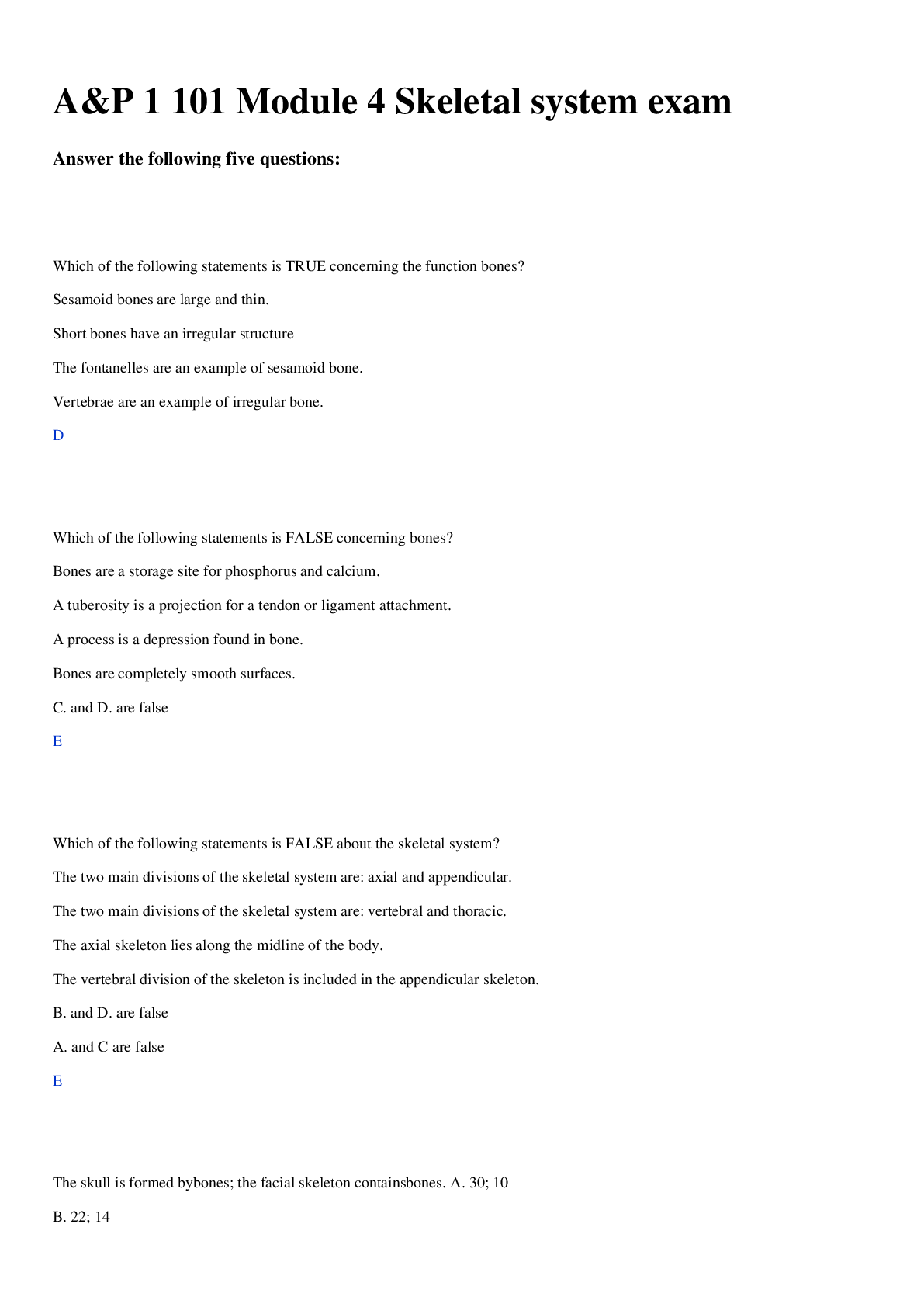
Buy this document to get the full access instantly
Instant Download Access after purchase
Add to cartInstant download
Also available in bundle (2)
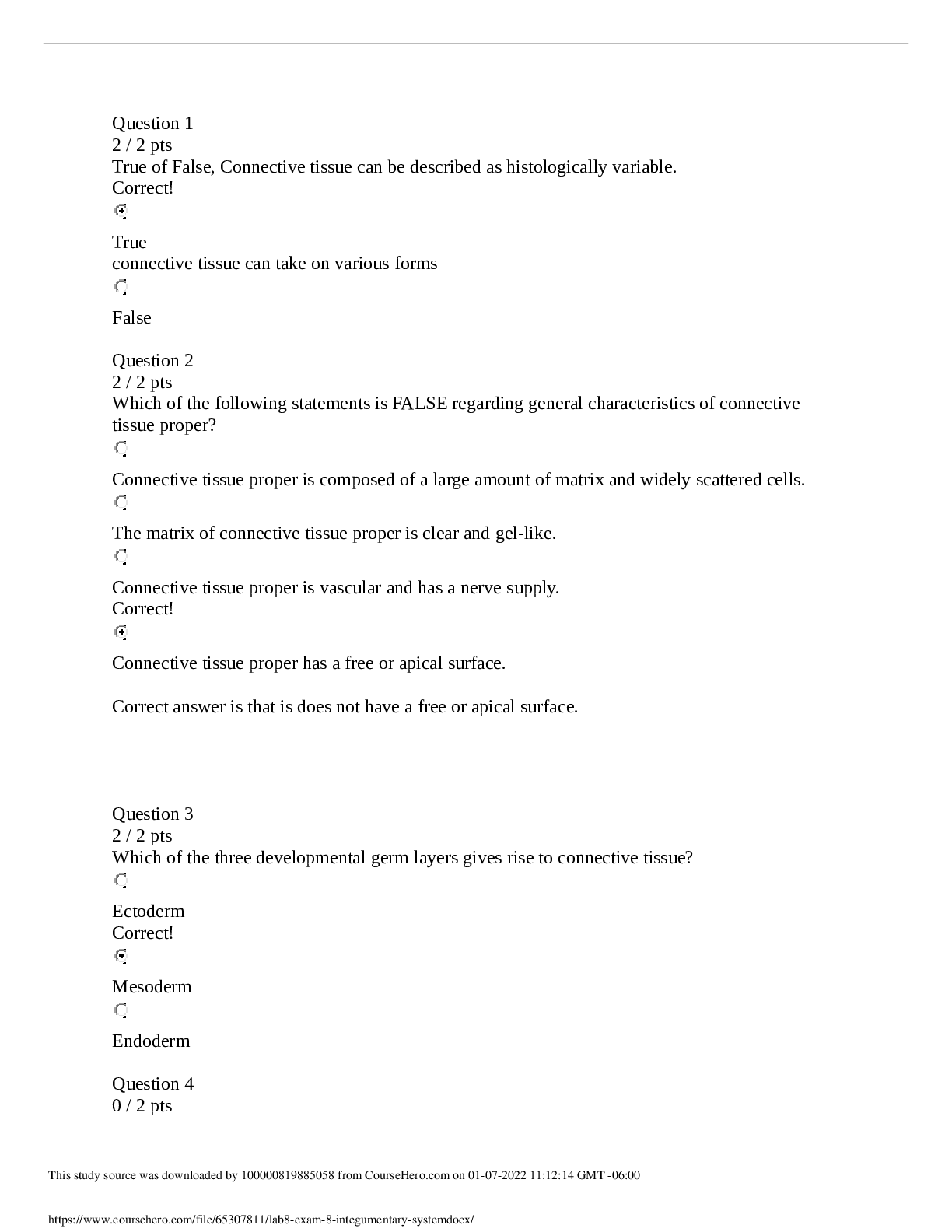
A&P 1 101 Module 1-8 Exam BUNDLE Comprehensive set Portage Learning (RATED A)
A&P 1 101 Module 1-8 Exam BUNDLE Comprehensive set Portage Learning (RATED A)
By Goodluck Academia 2 years ago
$14.5
8
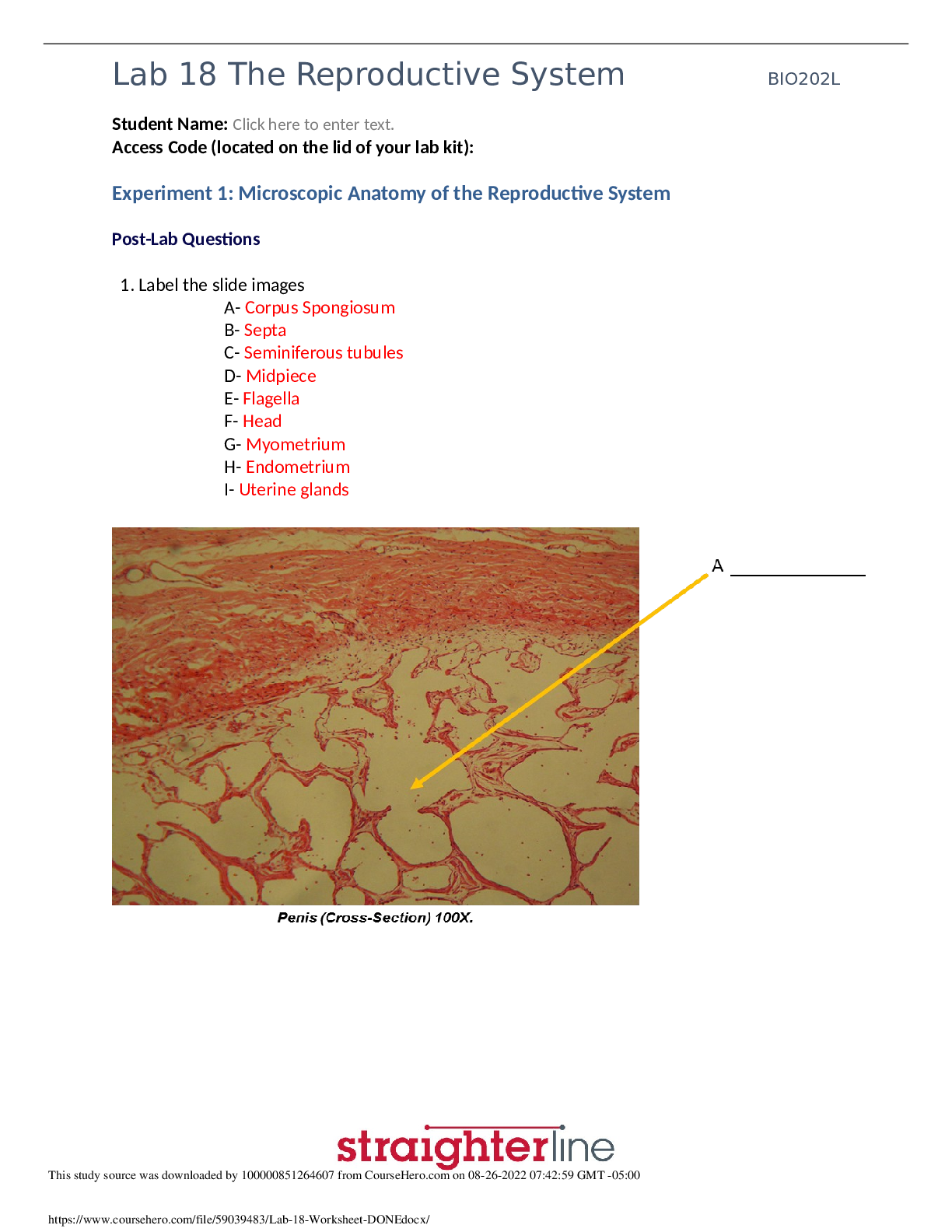
BIO 202L LAB Worksheets PACKAGE (LAB 10- LAB 18) Compiled | best Exam bundle for quick study (GUARANTEED PASS).
BIO 202L LAB Worksheets PACKAGE (LAB 10- LAB 18) Compiled | best Exam bundle for quick study (GUARANTEED PASS).
By Goodluck Academia 2 years ago
$14.5
17
Reviews( 0 )
Document information
Connected school, study & course
About the document
Uploaded On
Jun 29, 2021
Number of pages
42
Written in
Additional information
This document has been written for:
Uploaded
Jun 29, 2021
Downloads
0
Views
104
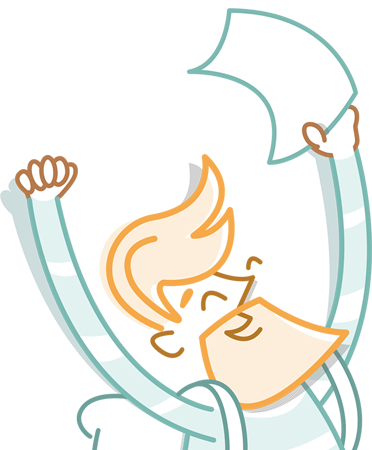
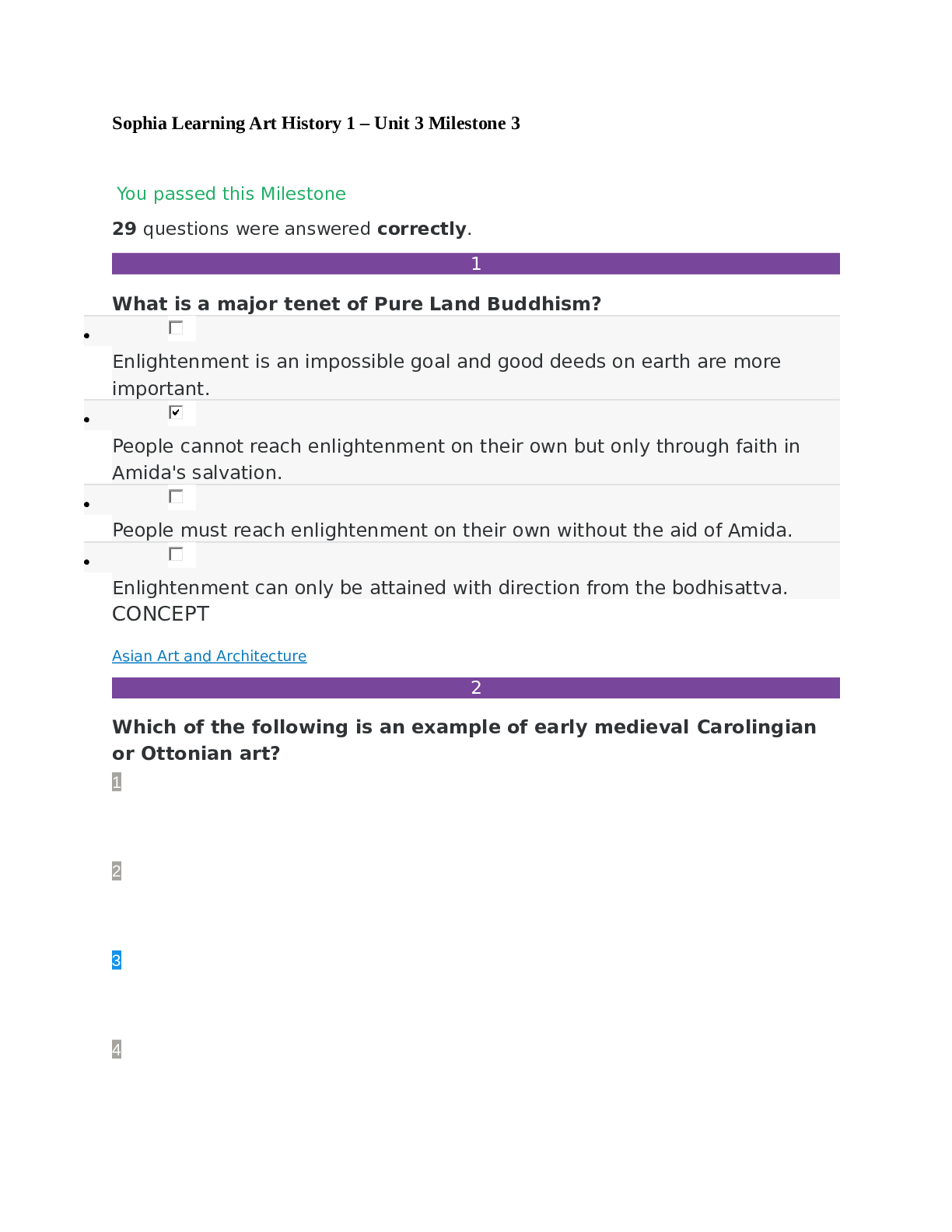
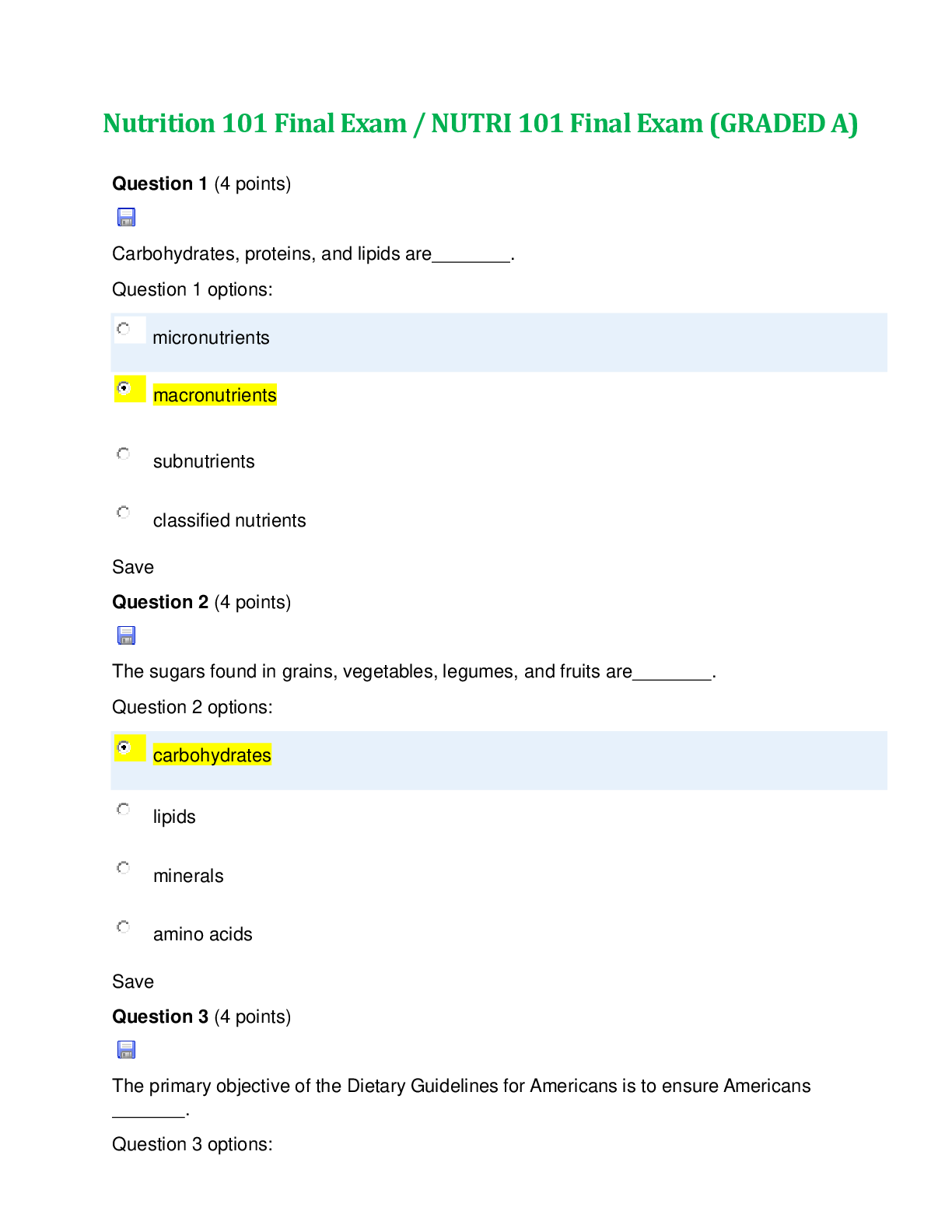
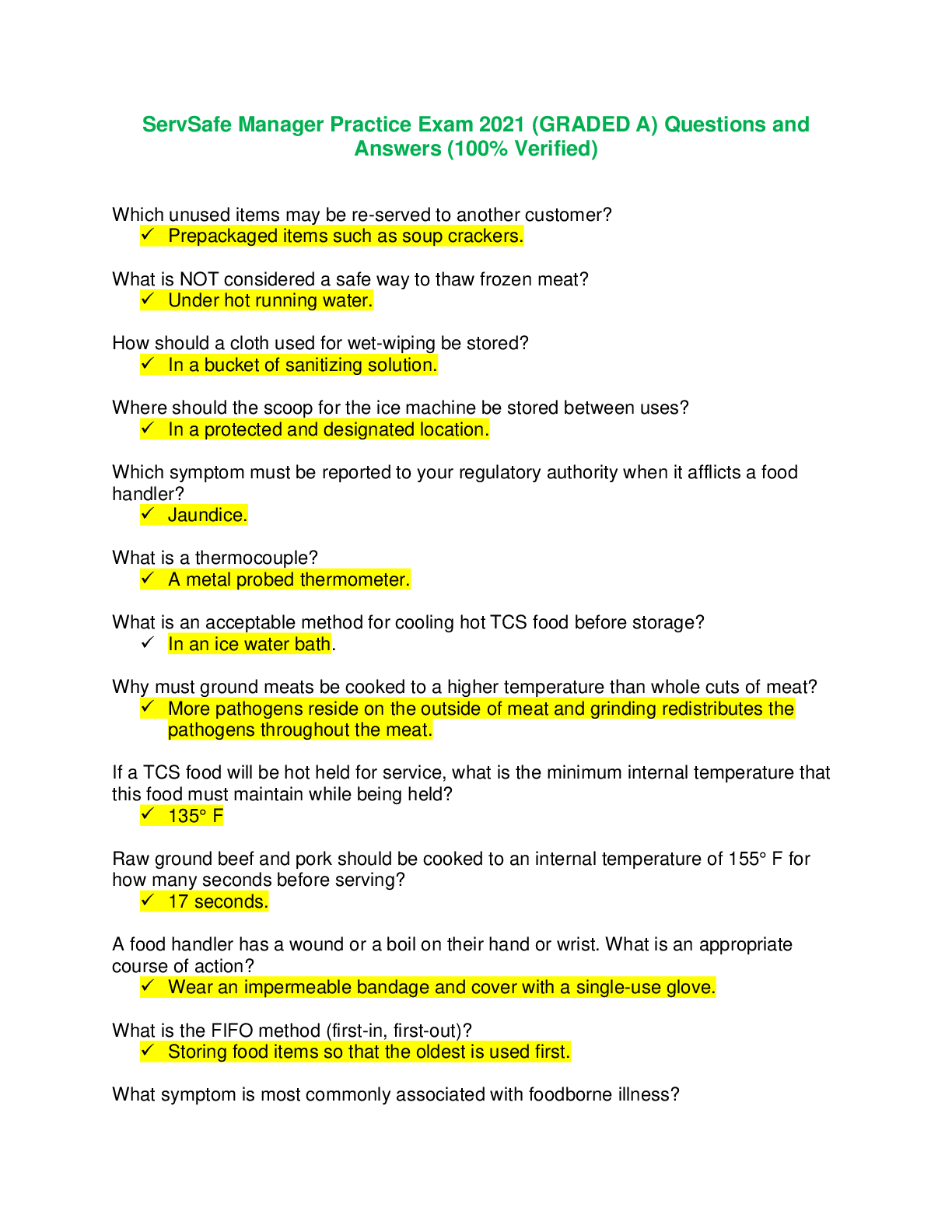
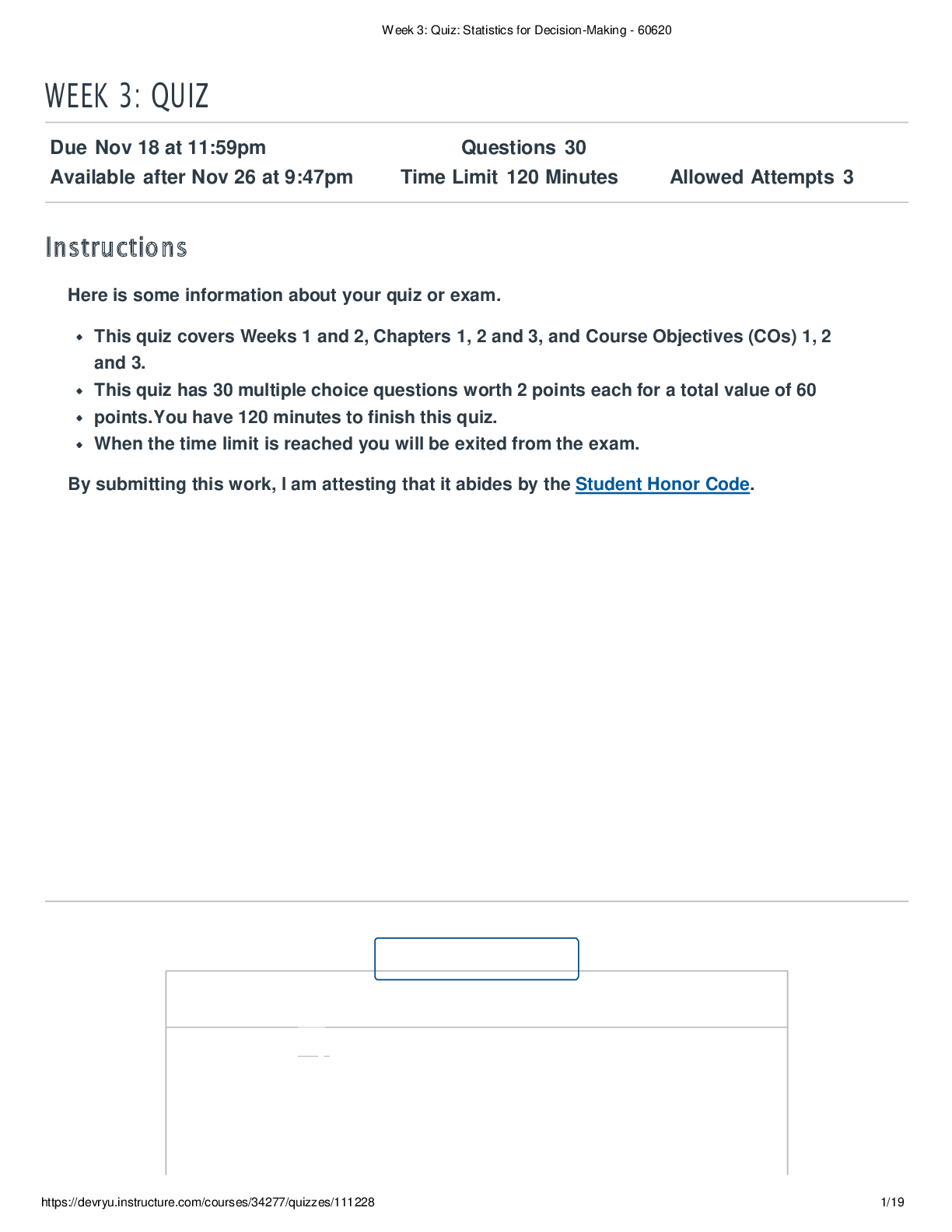
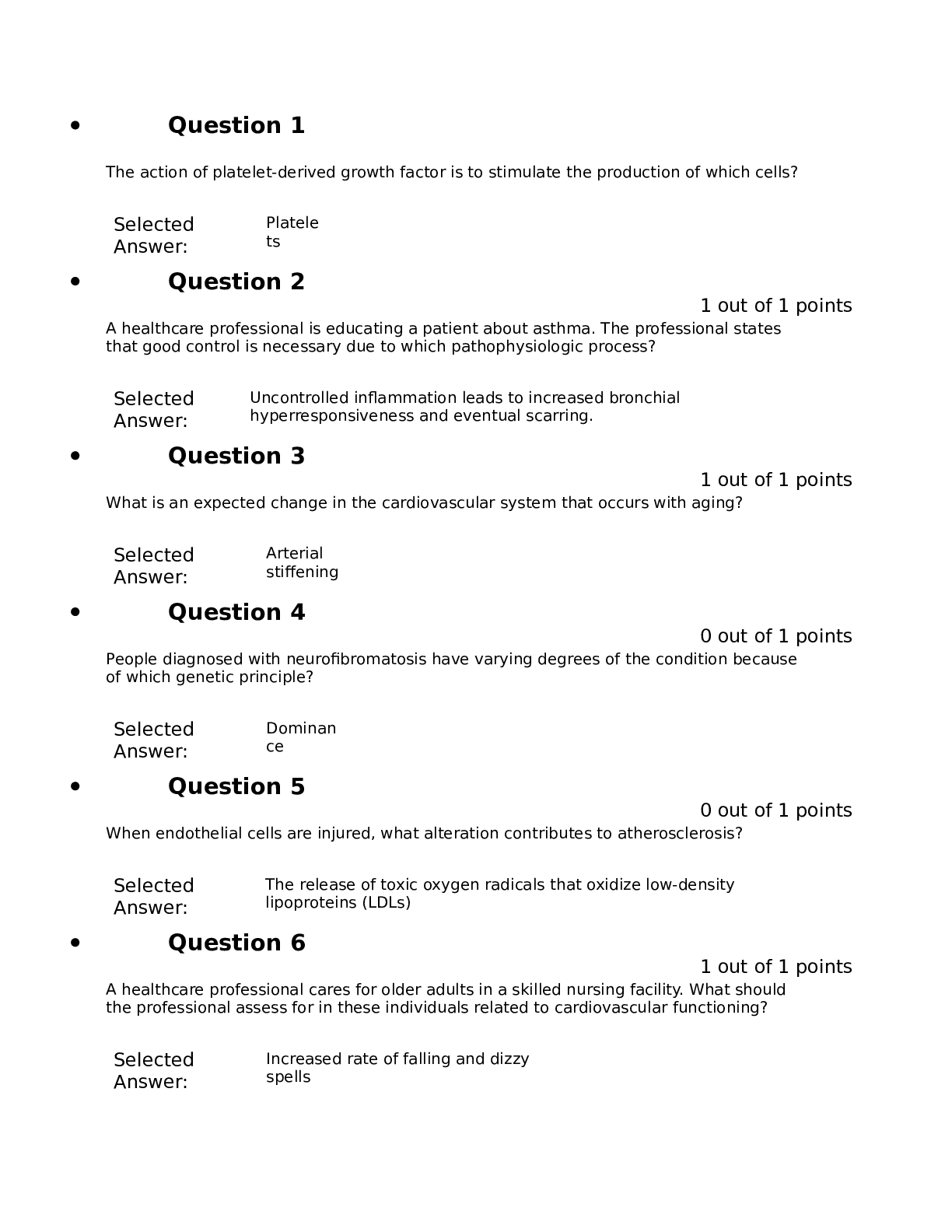
.png)
